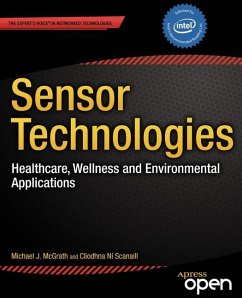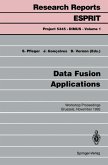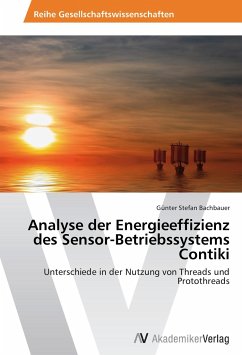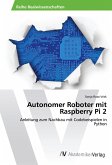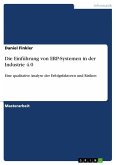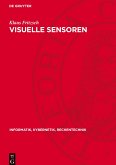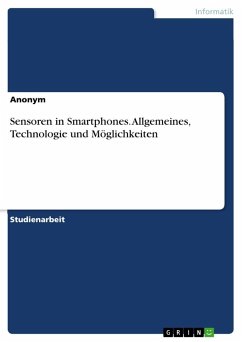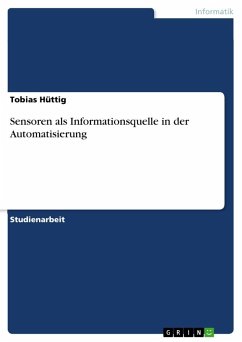Michael J. McGrath, Cliodhna Ni Scanaill, Dawn Nafus
Sensor Technologies
Healthcare, Wellness and Environmental Applications
Michael J. McGrath, Cliodhna Ni Scanaill, Dawn Nafus
Sensor Technologies
Healthcare, Wellness and Environmental Applications
- Broschiertes Buch
- Merkliste
- Auf die Merkliste
- Bewerten Bewerten
- Teilen
- Produkt teilen
- Produkterinnerung
- Produkterinnerung
Sensor Technologies: Healthcare, Wellness and Environmental Applications explores the key aspects of sensor technologies, covering wired, wireless, and discrete sensors for the specific application domains of healthcare, wellness and environmental sensing. It discusses the social, regulatory, and design considerations specific to these domains.
The book provides an application-based approach using real-world examples to illustrate the application of sensor technologies in a practical and experiential manner. The book guides the reader from the formulation of the research question, through…mehr
Andere Kunden interessierten sich auch für
![Data Fusion Applications Data Fusion Applications]() Data Fusion Applications41,99 €
Data Fusion Applications41,99 €![Analyse der Energieeffizienz des Sensor-Betriebssystems Contiki Analyse der Energieeffizienz des Sensor-Betriebssystems Contiki]() Günter Stefan BachbauerAnalyse der Energieeffizienz des Sensor-Betriebssystems Contiki43,95 €
Günter Stefan BachbauerAnalyse der Energieeffizienz des Sensor-Betriebssystems Contiki43,95 €![Autonomer Roboter mit Raspberry Pi 2 Autonomer Roboter mit Raspberry Pi 2]() Sonja Rosa VriskAutonomer Roboter mit Raspberry Pi 223,90 €
Sonja Rosa VriskAutonomer Roboter mit Raspberry Pi 223,90 €![Die Einführung von ERP-Systemen in der Industrie 4.0 Die Einführung von ERP-Systemen in der Industrie 4.0]() Daniel FinklerDie Einführung von ERP-Systemen in der Industrie 4.047,95 €
Daniel FinklerDie Einführung von ERP-Systemen in der Industrie 4.047,95 €![Visuelle Sensoren Visuelle Sensoren]() Klaus FritzschVisuelle Sensoren129,00 €
Klaus FritzschVisuelle Sensoren129,00 €![Sensoren in Smartphones. Allgemeines, Technologie und Möglichkeiten Sensoren in Smartphones. Allgemeines, Technologie und Möglichkeiten]() AnonymousSensoren in Smartphones. Allgemeines, Technologie und Möglichkeiten27,95 €
AnonymousSensoren in Smartphones. Allgemeines, Technologie und Möglichkeiten27,95 €![Sensoren als Informationsquelle in der Automatisierung Sensoren als Informationsquelle in der Automatisierung]() Tobias HüttigSensoren als Informationsquelle in der Automatisierung17,95 €
Tobias HüttigSensoren als Informationsquelle in der Automatisierung17,95 €-
-
-
Sensor Technologies: Healthcare, Wellness and Environmental Applications explores the key aspects of sensor technologies, covering wired, wireless, and discrete sensors for the specific application domains of healthcare, wellness and environmental sensing. It discusses the social, regulatory, and design considerations specific to these domains.
The book provides an application-based approach using real-world examples to illustrate the application of sensor technologies in a practical and experiential manner. The book guides the reader from the formulation of the research question, through the design and validation process, to the deployment and management phase of sensor applications. The processes and examples used in the book are primarily based on research carried out by Intel or joint academic research programs.
"Sensor Technologies: Healthcare, Wellness and Environmental Applications provides an extensive overview of sensing technologies and their applications in healthcare, wellness, and environmental monitoring. From sensor hardware to system applications and case studies, this book gives readers an in-depth understanding of the technologies and how they can be applied. I would highly recommend it to students or researchers who are interested in wireless sensing technologies and the associated applications."
Dr. Benny Lo
Lecturer, The Hamlyn Centre, Imperial College of London
"This timely addition to the literature on sensors covers the broad complexity of sensing, sensor types, and the vast range of existing and emerging applications in a very clearly written and accessible manner. It is particularly good at capturing the exciting possibilities that will occur as sensor networks merge with cloud-based 'big data' analytics to provide a host of new applications that will impact directly on the individual in ways we cannot fully predict at present. It really brings this home through the use of carefully chosen case studies that bring the overwhelming concept of 'big data' down to the personal level of individual life and health."
Dermot Diamond
Director, National Centre for Sensor Research, Principal Investigator, CLARITY Centre for Sensor Web Technologies, Dublin City University
"Sensor Technologies: Healthcare, Wellness and Environmental Applications takes the reader on an end-to-end journey of sensor technologies, covering the fundamentals from an engineering perspective, introducing how the data gleaned can be both processed and visualized, in addition to offering exemplar case studies in a number of application domains. It is a must-read for those studying any undergraduate course that involves sensor technologies. It also provides a thorough foundation for those involved in the research and development of applied sensor systems. I highly recommend it to any engineer who wishes to broaden their knowledge in this area!"
Chris Nugent
Professor of Biomedical Engineering, University of Ulster
The book provides an application-based approach using real-world examples to illustrate the application of sensor technologies in a practical and experiential manner. The book guides the reader from the formulation of the research question, through the design and validation process, to the deployment and management phase of sensor applications. The processes and examples used in the book are primarily based on research carried out by Intel or joint academic research programs.
"Sensor Technologies: Healthcare, Wellness and Environmental Applications provides an extensive overview of sensing technologies and their applications in healthcare, wellness, and environmental monitoring. From sensor hardware to system applications and case studies, this book gives readers an in-depth understanding of the technologies and how they can be applied. I would highly recommend it to students or researchers who are interested in wireless sensing technologies and the associated applications."
Dr. Benny Lo
Lecturer, The Hamlyn Centre, Imperial College of London
"This timely addition to the literature on sensors covers the broad complexity of sensing, sensor types, and the vast range of existing and emerging applications in a very clearly written and accessible manner. It is particularly good at capturing the exciting possibilities that will occur as sensor networks merge with cloud-based 'big data' analytics to provide a host of new applications that will impact directly on the individual in ways we cannot fully predict at present. It really brings this home through the use of carefully chosen case studies that bring the overwhelming concept of 'big data' down to the personal level of individual life and health."
Dermot Diamond
Director, National Centre for Sensor Research, Principal Investigator, CLARITY Centre for Sensor Web Technologies, Dublin City University
"Sensor Technologies: Healthcare, Wellness and Environmental Applications takes the reader on an end-to-end journey of sensor technologies, covering the fundamentals from an engineering perspective, introducing how the data gleaned can be both processed and visualized, in addition to offering exemplar case studies in a number of application domains. It is a must-read for those studying any undergraduate course that involves sensor technologies. It also provides a thorough foundation for those involved in the research and development of applied sensor systems. I highly recommend it to any engineer who wishes to broaden their knowledge in this area!"
Chris Nugent
Professor of Biomedical Engineering, University of Ulster
Produktdetails
- Produktdetails
- Verlag: Apress / Intel Corporation / Springer, Berlin
- Artikelnr. des Verlages: 86251182, 978-1-4302-6013-4
- 1st ed.
- Seitenzahl: 332
- Erscheinungstermin: 21. Dezember 2013
- Englisch
- Abmessung: 235mm x 191mm x 19mm
- Gewicht: 634g
- ISBN-13: 9781430260134
- ISBN-10: 1430260130
- Artikelnr.: 37535845
- Herstellerkennzeichnung
- Books on Demand GmbH
- In de Tarpen 42
- 22848 Norderstedt
- info@bod.de
- 040 53433511
- Verlag: Apress / Intel Corporation / Springer, Berlin
- Artikelnr. des Verlages: 86251182, 978-1-4302-6013-4
- 1st ed.
- Seitenzahl: 332
- Erscheinungstermin: 21. Dezember 2013
- Englisch
- Abmessung: 235mm x 191mm x 19mm
- Gewicht: 634g
- ISBN-13: 9781430260134
- ISBN-10: 1430260130
- Artikelnr.: 37535845
- Herstellerkennzeichnung
- Books on Demand GmbH
- In de Tarpen 42
- 22848 Norderstedt
- info@bod.de
- 040 53433511
Michael J. McGrath is a researcher with Intel Labs. He is also a principle investigator in the TRIL Centre which is focused on the development of technologies to address the physical, social and cognitive consequences of aging. His areas of interest include wireless sensors, ambient sensor platforms, assisted living technologies, user interface design and data management techniques. He is a co-author of the book Wireless Sensor Networks for Healthcare Applications published by Artech House. Michael holds a PhD from Dublin City University in sensors and electroanalytical instrumentation.
Chapter One: Introduction
Chapter Goal: Reader should understand the key challenges and drivers
for sensor application development. The reader should also understand how
sensor technologies can play a role in addressing some of the key
challenges facing global society in the short to medium term. 1. Book
overview 2. Drivers for Sensor Applications (Infrastructure Growth in
Developing Countries, Advances in Energy Harvesting, New Applications, Cost
reduction, Real-time monitoring of situations to avoid unplanned downtime,
Security (personal and national), the internet of things). 3.
Challenges for Sensor Applications (Power, Efficient Operation in Harsh
Environments, Number of Deployable Nodes, Safety and Regulations, High Cost
of Installation, Security and Reliability, sensor management) 4.
Global Megatrends and the opportunities for sensing technologies o Water
and Food Constraints o Aging Demographics o Public Health o
Pandemics o Security
Chapter 2: Sensing and Sensor Fundamentals
Chapter Goal: Reader should understand existing sensor technologies,
which can be used in healthcare, wellness, and environmental domains. They
should also understand the role of smart sensors and smart phones as mobile
sensing platforms and aggregators. 1. Sensing Modalities (Mechanical,
MEMS, Optical, ISFET, µTAS) 2. Sensing Domains (Air, Water, Noise,
Bacterial, Chemical, Kinematic, DNA, Physiological) 3. Functional
Characterisation of Sensors o Communication methods - discrete, wired,
wireless o Smart Sensors and Sensor Platforms § MSP430 (SHIMMER and
telosB motes) § ATmega § PIC 4. Smart Phones as mobile sensor
platforms 5. Selecting and specifying sensors
Chapter 3 Key Sensor Technology Components - Hardware and Software Overview
Chapter Goal: Reader should have a high level understanding of the key
hardware and software components, which are necessary for the development
of sensors systems and why technologies are selected for specific
applications. 1. Overview - Sensor systems 2. MCU's (TI MSP430,
ATmega, PIC) a. ADCs b. Interrupts c. Real-time Clocks
3. Sensor Interfaces a. Digital b. Analog c. I2C
4. Communications - wired and wireless interfaces RS232/485, USB,
Ethernet, FieldbusProprietary Short Range Wireless Protocols (e.g. ANT,
BodyLAN, Sensium)Standard Short Range Protocols
i. IEEE
802.15.6
ii. Bluetooth/Smart Bluetooth
iii.
802.15.4
iv. UWB Medium Range
i.
Wi-Fi 5. Data storage (EEPROM, sd card, data forwarding) 6.
Power management and Energy Harvesting 7. Operating Systems and
Software Development Environments (SDK's)
Chapter 4 Sensor Network Architectures
Chapter Goal: Reader should understand the various approaches to the
design of sensor network architectures; scaling from body worn systems, to
ambient sensing, to city-scale deployments. The reader should also
understand the advantages and disadvantages of current and evolving sensor
network architectures. 1. Sensor network architectures o Discrete
Sensor o Sensor to aggregator o PAN/WPAN/smart clothing o
Pervasive/Ambient sensor networks o Wide area networks (city-wide,
country wide) 2. Challenges in developing and deploying sensor
networks 3. Current and Proposed Solutions o Remote sensor
management o Edge Processing o Power harvesting o New
communication standards Chapter 5: Adding Vibrancy to Sensor Data Chapter
Goal: Reader should understand the various methods to interpret and
display sensor data to the user. They will understand the importance of
creating a data analysis plan from the outset, and the different types of
data analysis throughout the application stack. 1. Data Literacy -
How can we intuitively answer questions with sensor data and contextualise
answers 2. Data Quality a. Calibration b. Trust and
Repudiation 3. Sensor Fusion - combining sensory data from disparate
sources 4. Data Mining 5. Data Visualisation 6. Openness,
data integration, virtual sensors 7. Exploiting the power of the
cloud
Chapter 6: Regulation and Standards
Chapter Goal: Reader should understand the key technologies, which
impact or influence the development of sensor deployment and applications
including the emerging standards and regulatory considerations. 1.
Regulatory Standards (US, EU, Japan) : why, which, and how standards impact
your application 2. Regulatory Issues: Certification 3.
Smartphones Considerations o Privacy and data security 4.
Standards Bodies and Industry Groups o Continua Healthcare Alliance o
ISO/IEEE 11073 5. Wearable Wireless Health Communication Standards
Chapter 7: Biosensing in Everyday Life - Driving Biocontextual Aware
Computing
Chapter Goal: Reader should understand the social relationships that
create opportunities and barriers for widespread, consumer-based
biosensing. The reader should understand how the social world is shifting
from sensor technologies of "should" to sensor technologies of "could" to
facilitate new understandings of health and wellness and drive new methods
and practices of personal data sharing. 1. Data Security and
Ownership - Sharing and Managing Personal Data 2. Game Changing
Pressure for Affordable Healthcare 3. Continuous, Personal Data is
Improving Lives 4. Emerging Tech-Empowered Citizens 5. Sensing
for Self-Discovery, Culture and Play 6. User feedback/Supporting
sustainable human behaviours - leveraging the gaming culture
Chapter 8: Development and Deployment of Sensor Technologies for Home and
Community Settings
Chapter Goal: Reader should understand how to design a sensor
deployment for a home or community. The chapter informs the reader how to
formulate the research question the deployment will address, how to develop
prototypes, and manage and deploy them successful. The chapter will finish
with exemplar case studies of real world sensor deployments. Study Design -
The Right QuestionHome Deployment ElementsHome Deployment ManagementThe
Prototyping Design ProcessCase Studies
Chapter 9: Body Worn and Ambient Sensor Applications for Assessment,
Monitoring, and Diagnostics
Chapter Goal: Reader should at the end of this chapter have an
understanding of the key characteristics of how body worn and ambient
sensor applications, and how they vary according to the domain in which
they are deployed. The reader will be presented with the key challenges
faced in each domain, and emerging solutions for these challenges. 1.
Drivers and Inhibitors (Incidence of chronic diseases, aging demographics,
Adjusting provider compensation, prevention, medical work practice changes)
2. Hospital based sensing for assessment and diagnosis 3.
Supervised Assessment and Monitoring in Community Settings 4. Home
Based Applications o Clinical grade sensing for patient monitoring o
Body worn sensing (e.g. PERS) for monitoring and alerting o Passive
sensing for monitoring and alerting (e.g. ADL's) 5. Key challenges
Chapter 10: Wellness, Fitness and Lifestyle
Chapter Goal: Reader should understand the key trends in how people use
body worn sensors to manage their fitness and wellbeing. Key applications
include: sensors for measuring activities in sports performance,
activity/weight management and sleep tracking, 1. Drivers and
Inhibitors 2. Sports and fitness applications (running, walking
cycling, field sports) § Vital signs and physiological parameters §
Fitness gaming - Wii Fit, Kinect § muscle movement, body stress levels,
speed, distance, location § Fitness Statistics and Analysis 3.
Outdoor Activities o Pressure (mountaineer and paragliding) o GPS
(hiking, cycling, golf) 4. Obesity and weight management 5.
Sleep o Baby Monitoring o Sleep Quality - health and social impacts
o Sleep Apnoea
Chapter 11: Environmental Monitoring for Health and Wellness
Chapter Goal: Reader should understand how sensors and sensor networks
are used for environmental monitoring, one of the key emerging applications
domains. Apart from disaster monitoring, sensing also has the potential for
air quality, weather monitoring, pollution etc.; with benefits for both
urban and rural dwellers. 1. Drivers and Inhibitors o Correlations
to health impacts 2. Home Sensing o Carbon Monoxide o Smoke
Detectors o Passive Infrared (PIR) o Temperature o Sound o
Sustainable Living 3. Smart Environments 4. Environmental
Parameters (Noise, Water, Bacteria, Air Quality, Radiation, Urban Heat
Islands) 5. Weather - Exceptional Event and Disaster Management
Intelligence
Chapter 12: Conclusions and Future Directions
Chapter Goal: Reader should understand the key conclusions that the
authors have outlined in the previous chapters. The reader should also
gain an understanding of the key trends which will affect future sensor
applications and how people will utilise these novel applications in their
everyday lives. 1. Summary of the overall conclusions 2. Future
Directions for Sensing o Use Centred Healthcare o Citizen centric
sensing o Influence of urbanisation on health, wellness and lifestyle
choices. o Sustainable human behaviour change
Chapter Goal: Reader should understand the key challenges and drivers
for sensor application development. The reader should also understand how
sensor technologies can play a role in addressing some of the key
challenges facing global society in the short to medium term. 1. Book
overview 2. Drivers for Sensor Applications (Infrastructure Growth in
Developing Countries, Advances in Energy Harvesting, New Applications, Cost
reduction, Real-time monitoring of situations to avoid unplanned downtime,
Security (personal and national), the internet of things). 3.
Challenges for Sensor Applications (Power, Efficient Operation in Harsh
Environments, Number of Deployable Nodes, Safety and Regulations, High Cost
of Installation, Security and Reliability, sensor management) 4.
Global Megatrends and the opportunities for sensing technologies o Water
and Food Constraints o Aging Demographics o Public Health o
Pandemics o Security
Chapter 2: Sensing and Sensor Fundamentals
Chapter Goal: Reader should understand existing sensor technologies,
which can be used in healthcare, wellness, and environmental domains. They
should also understand the role of smart sensors and smart phones as mobile
sensing platforms and aggregators. 1. Sensing Modalities (Mechanical,
MEMS, Optical, ISFET, µTAS) 2. Sensing Domains (Air, Water, Noise,
Bacterial, Chemical, Kinematic, DNA, Physiological) 3. Functional
Characterisation of Sensors o Communication methods - discrete, wired,
wireless o Smart Sensors and Sensor Platforms § MSP430 (SHIMMER and
telosB motes) § ATmega § PIC 4. Smart Phones as mobile sensor
platforms 5. Selecting and specifying sensors
Chapter 3 Key Sensor Technology Components - Hardware and Software Overview
Chapter Goal: Reader should have a high level understanding of the key
hardware and software components, which are necessary for the development
of sensors systems and why technologies are selected for specific
applications. 1. Overview - Sensor systems 2. MCU's (TI MSP430,
ATmega, PIC) a. ADCs b. Interrupts c. Real-time Clocks
3. Sensor Interfaces a. Digital b. Analog c. I2C
4. Communications - wired and wireless interfaces RS232/485, USB,
Ethernet, FieldbusProprietary Short Range Wireless Protocols (e.g. ANT,
BodyLAN, Sensium)Standard Short Range Protocols
i. IEEE
802.15.6
ii. Bluetooth/Smart Bluetooth
iii.
802.15.4
iv. UWB Medium Range
i.
Wi-Fi 5. Data storage (EEPROM, sd card, data forwarding) 6.
Power management and Energy Harvesting 7. Operating Systems and
Software Development Environments (SDK's)
Chapter 4 Sensor Network Architectures
Chapter Goal: Reader should understand the various approaches to the
design of sensor network architectures; scaling from body worn systems, to
ambient sensing, to city-scale deployments. The reader should also
understand the advantages and disadvantages of current and evolving sensor
network architectures. 1. Sensor network architectures o Discrete
Sensor o Sensor to aggregator o PAN/WPAN/smart clothing o
Pervasive/Ambient sensor networks o Wide area networks (city-wide,
country wide) 2. Challenges in developing and deploying sensor
networks 3. Current and Proposed Solutions o Remote sensor
management o Edge Processing o Power harvesting o New
communication standards Chapter 5: Adding Vibrancy to Sensor Data Chapter
Goal: Reader should understand the various methods to interpret and
display sensor data to the user. They will understand the importance of
creating a data analysis plan from the outset, and the different types of
data analysis throughout the application stack. 1. Data Literacy -
How can we intuitively answer questions with sensor data and contextualise
answers 2. Data Quality a. Calibration b. Trust and
Repudiation 3. Sensor Fusion - combining sensory data from disparate
sources 4. Data Mining 5. Data Visualisation 6. Openness,
data integration, virtual sensors 7. Exploiting the power of the
cloud
Chapter 6: Regulation and Standards
Chapter Goal: Reader should understand the key technologies, which
impact or influence the development of sensor deployment and applications
including the emerging standards and regulatory considerations. 1.
Regulatory Standards (US, EU, Japan) : why, which, and how standards impact
your application 2. Regulatory Issues: Certification 3.
Smartphones Considerations o Privacy and data security 4.
Standards Bodies and Industry Groups o Continua Healthcare Alliance o
ISO/IEEE 11073 5. Wearable Wireless Health Communication Standards
Chapter 7: Biosensing in Everyday Life - Driving Biocontextual Aware
Computing
Chapter Goal: Reader should understand the social relationships that
create opportunities and barriers for widespread, consumer-based
biosensing. The reader should understand how the social world is shifting
from sensor technologies of "should" to sensor technologies of "could" to
facilitate new understandings of health and wellness and drive new methods
and practices of personal data sharing. 1. Data Security and
Ownership - Sharing and Managing Personal Data 2. Game Changing
Pressure for Affordable Healthcare 3. Continuous, Personal Data is
Improving Lives 4. Emerging Tech-Empowered Citizens 5. Sensing
for Self-Discovery, Culture and Play 6. User feedback/Supporting
sustainable human behaviours - leveraging the gaming culture
Chapter 8: Development and Deployment of Sensor Technologies for Home and
Community Settings
Chapter Goal: Reader should understand how to design a sensor
deployment for a home or community. The chapter informs the reader how to
formulate the research question the deployment will address, how to develop
prototypes, and manage and deploy them successful. The chapter will finish
with exemplar case studies of real world sensor deployments. Study Design -
The Right QuestionHome Deployment ElementsHome Deployment ManagementThe
Prototyping Design ProcessCase Studies
Chapter 9: Body Worn and Ambient Sensor Applications for Assessment,
Monitoring, and Diagnostics
Chapter Goal: Reader should at the end of this chapter have an
understanding of the key characteristics of how body worn and ambient
sensor applications, and how they vary according to the domain in which
they are deployed. The reader will be presented with the key challenges
faced in each domain, and emerging solutions for these challenges. 1.
Drivers and Inhibitors (Incidence of chronic diseases, aging demographics,
Adjusting provider compensation, prevention, medical work practice changes)
2. Hospital based sensing for assessment and diagnosis 3.
Supervised Assessment and Monitoring in Community Settings 4. Home
Based Applications o Clinical grade sensing for patient monitoring o
Body worn sensing (e.g. PERS) for monitoring and alerting o Passive
sensing for monitoring and alerting (e.g. ADL's) 5. Key challenges
Chapter 10: Wellness, Fitness and Lifestyle
Chapter Goal: Reader should understand the key trends in how people use
body worn sensors to manage their fitness and wellbeing. Key applications
include: sensors for measuring activities in sports performance,
activity/weight management and sleep tracking, 1. Drivers and
Inhibitors 2. Sports and fitness applications (running, walking
cycling, field sports) § Vital signs and physiological parameters §
Fitness gaming - Wii Fit, Kinect § muscle movement, body stress levels,
speed, distance, location § Fitness Statistics and Analysis 3.
Outdoor Activities o Pressure (mountaineer and paragliding) o GPS
(hiking, cycling, golf) 4. Obesity and weight management 5.
Sleep o Baby Monitoring o Sleep Quality - health and social impacts
o Sleep Apnoea
Chapter 11: Environmental Monitoring for Health and Wellness
Chapter Goal: Reader should understand how sensors and sensor networks
are used for environmental monitoring, one of the key emerging applications
domains. Apart from disaster monitoring, sensing also has the potential for
air quality, weather monitoring, pollution etc.; with benefits for both
urban and rural dwellers. 1. Drivers and Inhibitors o Correlations
to health impacts 2. Home Sensing o Carbon Monoxide o Smoke
Detectors o Passive Infrared (PIR) o Temperature o Sound o
Sustainable Living 3. Smart Environments 4. Environmental
Parameters (Noise, Water, Bacteria, Air Quality, Radiation, Urban Heat
Islands) 5. Weather - Exceptional Event and Disaster Management
Intelligence
Chapter 12: Conclusions and Future Directions
Chapter Goal: Reader should understand the key conclusions that the
authors have outlined in the previous chapters. The reader should also
gain an understanding of the key trends which will affect future sensor
applications and how people will utilise these novel applications in their
everyday lives. 1. Summary of the overall conclusions 2. Future
Directions for Sensing o Use Centred Healthcare o Citizen centric
sensing o Influence of urbanisation on health, wellness and lifestyle
choices. o Sustainable human behaviour change
Chapter One: Introduction
Chapter Goal: Reader should understand the key challenges and drivers
for sensor application development. The reader should also understand how
sensor technologies can play a role in addressing some of the key
challenges facing global society in the short to medium term. 1. Book
overview 2. Drivers for Sensor Applications (Infrastructure Growth in
Developing Countries, Advances in Energy Harvesting, New Applications, Cost
reduction, Real-time monitoring of situations to avoid unplanned downtime,
Security (personal and national), the internet of things). 3.
Challenges for Sensor Applications (Power, Efficient Operation in Harsh
Environments, Number of Deployable Nodes, Safety and Regulations, High Cost
of Installation, Security and Reliability, sensor management) 4.
Global Megatrends and the opportunities for sensing technologies o Water
and Food Constraints o Aging Demographics o Public Health o
Pandemics o Security
Chapter 2: Sensing and Sensor Fundamentals
Chapter Goal: Reader should understand existing sensor technologies,
which can be used in healthcare, wellness, and environmental domains. They
should also understand the role of smart sensors and smart phones as mobile
sensing platforms and aggregators. 1. Sensing Modalities (Mechanical,
MEMS, Optical, ISFET, µTAS) 2. Sensing Domains (Air, Water, Noise,
Bacterial, Chemical, Kinematic, DNA, Physiological) 3. Functional
Characterisation of Sensors o Communication methods - discrete, wired,
wireless o Smart Sensors and Sensor Platforms § MSP430 (SHIMMER and
telosB motes) § ATmega § PIC 4. Smart Phones as mobile sensor
platforms 5. Selecting and specifying sensors
Chapter 3 Key Sensor Technology Components - Hardware and Software Overview
Chapter Goal: Reader should have a high level understanding of the key
hardware and software components, which are necessary for the development
of sensors systems and why technologies are selected for specific
applications. 1. Overview - Sensor systems 2. MCU's (TI MSP430,
ATmega, PIC) a. ADCs b. Interrupts c. Real-time Clocks
3. Sensor Interfaces a. Digital b. Analog c. I2C
4. Communications - wired and wireless interfaces RS232/485, USB,
Ethernet, FieldbusProprietary Short Range Wireless Protocols (e.g. ANT,
BodyLAN, Sensium)Standard Short Range Protocols
i. IEEE
802.15.6
ii. Bluetooth/Smart Bluetooth
iii.
802.15.4
iv. UWB Medium Range
i.
Wi-Fi 5. Data storage (EEPROM, sd card, data forwarding) 6.
Power management and Energy Harvesting 7. Operating Systems and
Software Development Environments (SDK's)
Chapter 4 Sensor Network Architectures
Chapter Goal: Reader should understand the various approaches to the
design of sensor network architectures; scaling from body worn systems, to
ambient sensing, to city-scale deployments. The reader should also
understand the advantages and disadvantages of current and evolving sensor
network architectures. 1. Sensor network architectures o Discrete
Sensor o Sensor to aggregator o PAN/WPAN/smart clothing o
Pervasive/Ambient sensor networks o Wide area networks (city-wide,
country wide) 2. Challenges in developing and deploying sensor
networks 3. Current and Proposed Solutions o Remote sensor
management o Edge Processing o Power harvesting o New
communication standards Chapter 5: Adding Vibrancy to Sensor Data Chapter
Goal: Reader should understand the various methods to interpret and
display sensor data to the user. They will understand the importance of
creating a data analysis plan from the outset, and the different types of
data analysis throughout the application stack. 1. Data Literacy -
How can we intuitively answer questions with sensor data and contextualise
answers 2. Data Quality a. Calibration b. Trust and
Repudiation 3. Sensor Fusion - combining sensory data from disparate
sources 4. Data Mining 5. Data Visualisation 6. Openness,
data integration, virtual sensors 7. Exploiting the power of the
cloud
Chapter 6: Regulation and Standards
Chapter Goal: Reader should understand the key technologies, which
impact or influence the development of sensor deployment and applications
including the emerging standards and regulatory considerations. 1.
Regulatory Standards (US, EU, Japan) : why, which, and how standards impact
your application 2. Regulatory Issues: Certification 3.
Smartphones Considerations o Privacy and data security 4.
Standards Bodies and Industry Groups o Continua Healthcare Alliance o
ISO/IEEE 11073 5. Wearable Wireless Health Communication Standards
Chapter 7: Biosensing in Everyday Life - Driving Biocontextual Aware
Computing
Chapter Goal: Reader should understand the social relationships that
create opportunities and barriers for widespread, consumer-based
biosensing. The reader should understand how the social world is shifting
from sensor technologies of "should" to sensor technologies of "could" to
facilitate new understandings of health and wellness and drive new methods
and practices of personal data sharing. 1. Data Security and
Ownership - Sharing and Managing Personal Data 2. Game Changing
Pressure for Affordable Healthcare 3. Continuous, Personal Data is
Improving Lives 4. Emerging Tech-Empowered Citizens 5. Sensing
for Self-Discovery, Culture and Play 6. User feedback/Supporting
sustainable human behaviours - leveraging the gaming culture
Chapter 8: Development and Deployment of Sensor Technologies for Home and
Community Settings
Chapter Goal: Reader should understand how to design a sensor
deployment for a home or community. The chapter informs the reader how to
formulate the research question the deployment will address, how to develop
prototypes, and manage and deploy them successful. The chapter will finish
with exemplar case studies of real world sensor deployments. Study Design -
The Right QuestionHome Deployment ElementsHome Deployment ManagementThe
Prototyping Design ProcessCase Studies
Chapter 9: Body Worn and Ambient Sensor Applications for Assessment,
Monitoring, and Diagnostics
Chapter Goal: Reader should at the end of this chapter have an
understanding of the key characteristics of how body worn and ambient
sensor applications, and how they vary according to the domain in which
they are deployed. The reader will be presented with the key challenges
faced in each domain, and emerging solutions for these challenges. 1.
Drivers and Inhibitors (Incidence of chronic diseases, aging demographics,
Adjusting provider compensation, prevention, medical work practice changes)
2. Hospital based sensing for assessment and diagnosis 3.
Supervised Assessment and Monitoring in Community Settings 4. Home
Based Applications o Clinical grade sensing for patient monitoring o
Body worn sensing (e.g. PERS) for monitoring and alerting o Passive
sensing for monitoring and alerting (e.g. ADL's) 5. Key challenges
Chapter 10: Wellness, Fitness and Lifestyle
Chapter Goal: Reader should understand the key trends in how people use
body worn sensors to manage their fitness and wellbeing. Key applications
include: sensors for measuring activities in sports performance,
activity/weight management and sleep tracking, 1. Drivers and
Inhibitors 2. Sports and fitness applications (running, walking
cycling, field sports) § Vital signs and physiological parameters §
Fitness gaming - Wii Fit, Kinect § muscle movement, body stress levels,
speed, distance, location § Fitness Statistics and Analysis 3.
Outdoor Activities o Pressure (mountaineer and paragliding) o GPS
(hiking, cycling, golf) 4. Obesity and weight management 5.
Sleep o Baby Monitoring o Sleep Quality - health and social impacts
o Sleep Apnoea
Chapter 11: Environmental Monitoring for Health and Wellness
Chapter Goal: Reader should understand how sensors and sensor networks
are used for environmental monitoring, one of the key emerging applications
domains. Apart from disaster monitoring, sensing also has the potential for
air quality, weather monitoring, pollution etc.; with benefits for both
urban and rural dwellers. 1. Drivers and Inhibitors o Correlations
to health impacts 2. Home Sensing o Carbon Monoxide o Smoke
Detectors o Passive Infrared (PIR) o Temperature o Sound o
Sustainable Living 3. Smart Environments 4. Environmental
Parameters (Noise, Water, Bacteria, Air Quality, Radiation, Urban Heat
Islands) 5. Weather - Exceptional Event and Disaster Management
Intelligence
Chapter 12: Conclusions and Future Directions
Chapter Goal: Reader should understand the key conclusions that the
authors have outlined in the previous chapters. The reader should also
gain an understanding of the key trends which will affect future sensor
applications and how people will utilise these novel applications in their
everyday lives. 1. Summary of the overall conclusions 2. Future
Directions for Sensing o Use Centred Healthcare o Citizen centric
sensing o Influence of urbanisation on health, wellness and lifestyle
choices. o Sustainable human behaviour change
Chapter Goal: Reader should understand the key challenges and drivers
for sensor application development. The reader should also understand how
sensor technologies can play a role in addressing some of the key
challenges facing global society in the short to medium term. 1. Book
overview 2. Drivers for Sensor Applications (Infrastructure Growth in
Developing Countries, Advances in Energy Harvesting, New Applications, Cost
reduction, Real-time monitoring of situations to avoid unplanned downtime,
Security (personal and national), the internet of things). 3.
Challenges for Sensor Applications (Power, Efficient Operation in Harsh
Environments, Number of Deployable Nodes, Safety and Regulations, High Cost
of Installation, Security and Reliability, sensor management) 4.
Global Megatrends and the opportunities for sensing technologies o Water
and Food Constraints o Aging Demographics o Public Health o
Pandemics o Security
Chapter 2: Sensing and Sensor Fundamentals
Chapter Goal: Reader should understand existing sensor technologies,
which can be used in healthcare, wellness, and environmental domains. They
should also understand the role of smart sensors and smart phones as mobile
sensing platforms and aggregators. 1. Sensing Modalities (Mechanical,
MEMS, Optical, ISFET, µTAS) 2. Sensing Domains (Air, Water, Noise,
Bacterial, Chemical, Kinematic, DNA, Physiological) 3. Functional
Characterisation of Sensors o Communication methods - discrete, wired,
wireless o Smart Sensors and Sensor Platforms § MSP430 (SHIMMER and
telosB motes) § ATmega § PIC 4. Smart Phones as mobile sensor
platforms 5. Selecting and specifying sensors
Chapter 3 Key Sensor Technology Components - Hardware and Software Overview
Chapter Goal: Reader should have a high level understanding of the key
hardware and software components, which are necessary for the development
of sensors systems and why technologies are selected for specific
applications. 1. Overview - Sensor systems 2. MCU's (TI MSP430,
ATmega, PIC) a. ADCs b. Interrupts c. Real-time Clocks
3. Sensor Interfaces a. Digital b. Analog c. I2C
4. Communications - wired and wireless interfaces RS232/485, USB,
Ethernet, FieldbusProprietary Short Range Wireless Protocols (e.g. ANT,
BodyLAN, Sensium)Standard Short Range Protocols
i. IEEE
802.15.6
ii. Bluetooth/Smart Bluetooth
iii.
802.15.4
iv. UWB Medium Range
i.
Wi-Fi 5. Data storage (EEPROM, sd card, data forwarding) 6.
Power management and Energy Harvesting 7. Operating Systems and
Software Development Environments (SDK's)
Chapter 4 Sensor Network Architectures
Chapter Goal: Reader should understand the various approaches to the
design of sensor network architectures; scaling from body worn systems, to
ambient sensing, to city-scale deployments. The reader should also
understand the advantages and disadvantages of current and evolving sensor
network architectures. 1. Sensor network architectures o Discrete
Sensor o Sensor to aggregator o PAN/WPAN/smart clothing o
Pervasive/Ambient sensor networks o Wide area networks (city-wide,
country wide) 2. Challenges in developing and deploying sensor
networks 3. Current and Proposed Solutions o Remote sensor
management o Edge Processing o Power harvesting o New
communication standards Chapter 5: Adding Vibrancy to Sensor Data Chapter
Goal: Reader should understand the various methods to interpret and
display sensor data to the user. They will understand the importance of
creating a data analysis plan from the outset, and the different types of
data analysis throughout the application stack. 1. Data Literacy -
How can we intuitively answer questions with sensor data and contextualise
answers 2. Data Quality a. Calibration b. Trust and
Repudiation 3. Sensor Fusion - combining sensory data from disparate
sources 4. Data Mining 5. Data Visualisation 6. Openness,
data integration, virtual sensors 7. Exploiting the power of the
cloud
Chapter 6: Regulation and Standards
Chapter Goal: Reader should understand the key technologies, which
impact or influence the development of sensor deployment and applications
including the emerging standards and regulatory considerations. 1.
Regulatory Standards (US, EU, Japan) : why, which, and how standards impact
your application 2. Regulatory Issues: Certification 3.
Smartphones Considerations o Privacy and data security 4.
Standards Bodies and Industry Groups o Continua Healthcare Alliance o
ISO/IEEE 11073 5. Wearable Wireless Health Communication Standards
Chapter 7: Biosensing in Everyday Life - Driving Biocontextual Aware
Computing
Chapter Goal: Reader should understand the social relationships that
create opportunities and barriers for widespread, consumer-based
biosensing. The reader should understand how the social world is shifting
from sensor technologies of "should" to sensor technologies of "could" to
facilitate new understandings of health and wellness and drive new methods
and practices of personal data sharing. 1. Data Security and
Ownership - Sharing and Managing Personal Data 2. Game Changing
Pressure for Affordable Healthcare 3. Continuous, Personal Data is
Improving Lives 4. Emerging Tech-Empowered Citizens 5. Sensing
for Self-Discovery, Culture and Play 6. User feedback/Supporting
sustainable human behaviours - leveraging the gaming culture
Chapter 8: Development and Deployment of Sensor Technologies for Home and
Community Settings
Chapter Goal: Reader should understand how to design a sensor
deployment for a home or community. The chapter informs the reader how to
formulate the research question the deployment will address, how to develop
prototypes, and manage and deploy them successful. The chapter will finish
with exemplar case studies of real world sensor deployments. Study Design -
The Right QuestionHome Deployment ElementsHome Deployment ManagementThe
Prototyping Design ProcessCase Studies
Chapter 9: Body Worn and Ambient Sensor Applications for Assessment,
Monitoring, and Diagnostics
Chapter Goal: Reader should at the end of this chapter have an
understanding of the key characteristics of how body worn and ambient
sensor applications, and how they vary according to the domain in which
they are deployed. The reader will be presented with the key challenges
faced in each domain, and emerging solutions for these challenges. 1.
Drivers and Inhibitors (Incidence of chronic diseases, aging demographics,
Adjusting provider compensation, prevention, medical work practice changes)
2. Hospital based sensing for assessment and diagnosis 3.
Supervised Assessment and Monitoring in Community Settings 4. Home
Based Applications o Clinical grade sensing for patient monitoring o
Body worn sensing (e.g. PERS) for monitoring and alerting o Passive
sensing for monitoring and alerting (e.g. ADL's) 5. Key challenges
Chapter 10: Wellness, Fitness and Lifestyle
Chapter Goal: Reader should understand the key trends in how people use
body worn sensors to manage their fitness and wellbeing. Key applications
include: sensors for measuring activities in sports performance,
activity/weight management and sleep tracking, 1. Drivers and
Inhibitors 2. Sports and fitness applications (running, walking
cycling, field sports) § Vital signs and physiological parameters §
Fitness gaming - Wii Fit, Kinect § muscle movement, body stress levels,
speed, distance, location § Fitness Statistics and Analysis 3.
Outdoor Activities o Pressure (mountaineer and paragliding) o GPS
(hiking, cycling, golf) 4. Obesity and weight management 5.
Sleep o Baby Monitoring o Sleep Quality - health and social impacts
o Sleep Apnoea
Chapter 11: Environmental Monitoring for Health and Wellness
Chapter Goal: Reader should understand how sensors and sensor networks
are used for environmental monitoring, one of the key emerging applications
domains. Apart from disaster monitoring, sensing also has the potential for
air quality, weather monitoring, pollution etc.; with benefits for both
urban and rural dwellers. 1. Drivers and Inhibitors o Correlations
to health impacts 2. Home Sensing o Carbon Monoxide o Smoke
Detectors o Passive Infrared (PIR) o Temperature o Sound o
Sustainable Living 3. Smart Environments 4. Environmental
Parameters (Noise, Water, Bacteria, Air Quality, Radiation, Urban Heat
Islands) 5. Weather - Exceptional Event and Disaster Management
Intelligence
Chapter 12: Conclusions and Future Directions
Chapter Goal: Reader should understand the key conclusions that the
authors have outlined in the previous chapters. The reader should also
gain an understanding of the key trends which will affect future sensor
applications and how people will utilise these novel applications in their
everyday lives. 1. Summary of the overall conclusions 2. Future
Directions for Sensing o Use Centred Healthcare o Citizen centric
sensing o Influence of urbanisation on health, wellness and lifestyle
choices. o Sustainable human behaviour change

